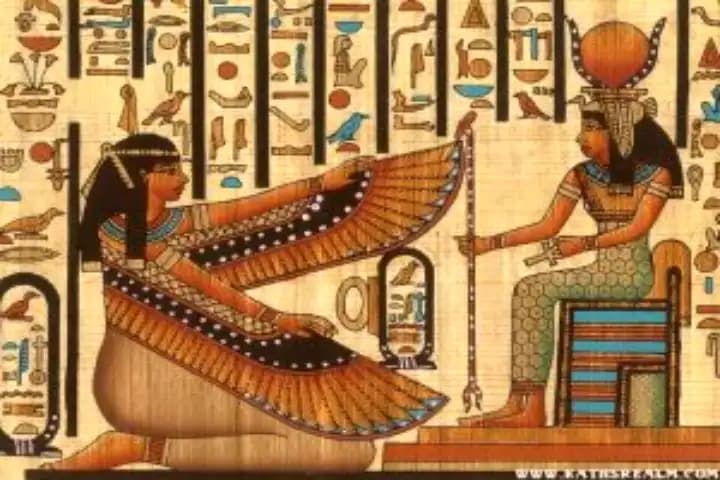
In Ancient Egyptian mythology, Nekhbet was one of the most prominent goddesses, worshipped for her association with motherhood and fertility. She was depicted as a vulture, a sacred bird that was believed to protect and nurture her devotees. Nekhbet was also considered the patron goddess of Upper Egypt, and her cult centers were located in the cities of Nekheb and Hierakonpolis. Her name, which means "she of Nekheb," reflects the importance of her role in the religious and cultural traditions of the region. Nekhbet was often depicted wearing the white crown of Upper Egypt, which symbolized her divine authority and power. She was also associated with the protection of pharaohs and the royal family, and her image was frequently found on the walls of temples and tombs.
The mythology of Nekhbet is intertwined with the history of Ancient Egypt. According to legend, she was born from the chaos that existed before creation, emerging as a vulture from the primordial waters. She was believed to be a powerful and benevolent goddess, who protected and nurtured her devotees, especially women and children. Nekhbet was also known as the "Great White Cow of Nekheb," a symbol of her nurturing and protective qualities.
In Ancient Egyptian mythology, Nekhbet was often depicted as a companion to the sun god, Ra. She was believed to be his protector and the guardian of the pharaohs, who were considered to be the living embodiment of Ra. Nekhbet was also associated with the goddess Isis, who was the mother of Horus, one of the most important deities in Ancient Egyptian mythology. Together, Nekhbet and Isis represented the nurturing and protective aspects of motherhood.
The vulture was a symbol of maternal love and protection in ancient Egypt, and Nekhbet was associated with these qualities. She was often depicted holding a pharaoh's cartouche, which symbolized her role as protector of the king and his royal lineage. Nekhbet was also associated with the concept of "maat," which represented order, truth, and justice. As a protector of the pharaoh, Nekhbet was seen as upholding the principles of maat and ensuring that justice was served.
Nekhbet was widely worshipped as the goddess of motherhood, fertility and childbirth. She was believed to have the power to bless women with fertility and to protect mothers and children during childbirth. Her image was often found on amulets worn by pregnant women, who sought her protection during this vulnerable time.
In Ancient Egyptian mythology, Nekhbet was also believed to be the protector of children, especially those who were abandoned or orphaned. She was often depicted with her wings spread wide, symbolizing her protective embrace of all children. The vulture, which was her sacred bird, was also associated with motherhood and nurturing, and was a symbol of fertility and abundance.
Nekhbet was also widely worshipped as the goddess of fertility, and her image was often found in fertility rituals and ceremonies. She was believed to have the power to bless the land with fertility and abundance, and to protect crops and livestock from harm. Her association with the vulture, which was a scavenger bird that fed on carrion, also symbolized the cycle of life and death, and the renewal of fertility and growth.
In Ancient Egyptian mythology, Nekhbet was often depicted with a basket of eggs, which symbolized her role as the bringer of new life and fertility. She was also associated with the goddess Hathor, who was the goddess of love, fertility and beauty. Together, Nekhbet and Hathor represented the life-giving and nurturing qualities of the feminine divine.
In Ancient Egyptian mythology, Nekhbet was often associated with other deities, particularly Ra, Isis and Hathor. She was believed to be the protector of Ra, and her image was often found on the walls of temples dedicated to him. Nekhbet was also associated with Isis, who was the mother of Horus, and Hathor, who was the goddess of love and fertility.
Nekhbet was also sometimes associated with the goddess Ma'at, who was the goddess of truth, justice and order. Ma'at was believed to be the source of all life, and her association with Nekhbet emphasized the life-giving and nurturing qualities of the feminine divine.
Nekhbet was widely worshipped throughout Ancient Egypt, and her cult centers were located in the cities of Nekheb and Hierakonpolis. Her temples were often located near the Nile River, which was the source of life and fertility in Ancient Egypt. The temple of Nekhbet in Nekheb was one of the most important religious sites in Upper Egypt, and it was believed to be the home of the goddess herself.
Nekhbet was worshipped through various rituals and ceremonies, including offerings of food, drink and incense. Her image was also often included in personal shrines and household altars, where she was worshipped as a protector and nurturer of families and children.
Nekhbet's influence can still be felt in modern times, particularly in the field of spirituality and alternative healing practices. Her association with motherhood, fertility and healing has made her a popular figure in modern goddess worship and neo-paganism.
Nekhbet's image can also be found in popular culture, particularly in video games and fantasy literature. Her association with protection and healing has made her a popular character in games and books that feature magical and mystical creatures.
Nekhbet's image can be found in popular culture, particularly in video games and fantasy literature. Her association with protection and healing has made her a popular character in games and books that feature magical and mystical creatures.
In the popular video game "Assassin's Creed: Origins," Nekhbet is depicted as a powerful and benevolent goddess, who protects and nurtures her devotees. Her image is also included in the popular card game, "Magic: The Gathering," where she is portrayed as a powerful and protective creature.
Nekhbet was a powerful and benevolent goddess, worshipped for her association with motherhood, fertility and protection. Her image can be found throughout Ancient Egyptian art and mythology, as well as in modern popular culture. The mythology of Nekhbet serves as a reminder of the life-giving and nurturing qualities of the feminine divine, and her legacy continues to inspire and influence people around the world.
“In my opinion, I believe a good writer makes content easy to read, and entertains the reader, making comprehension effortless. Egypt is a country that truly has it all. Its rich history, stunning landscapes, and friendly people make it a must-visit destination for any traveler. I hope you'll have the opportunity to experience it for yourself.
By Egypt Travel Blogger
Indulge in luxury aboard the MS Mayfair Nile cruise between Luxor and Aswan. Book now an amazing Nile Cruise vacation. ...
$ 799 | Per Person

Enjoy luxurious accommodation while sailing the Nile River between Luxor and Aswan aboard MS Farah nile cruise. Book Tod ...
$ 799 | Per Person

Discover the treasures of the Nile Valley aboard the magical Nile Goddess Cruise and visit the most famous and historica ...
$ 699 | Per Person